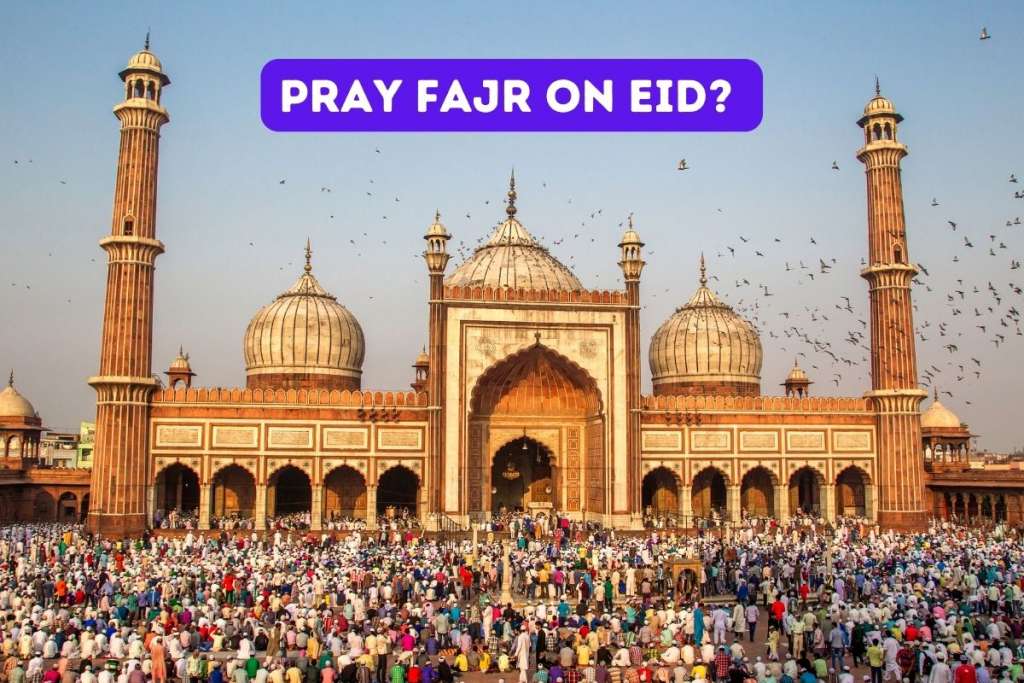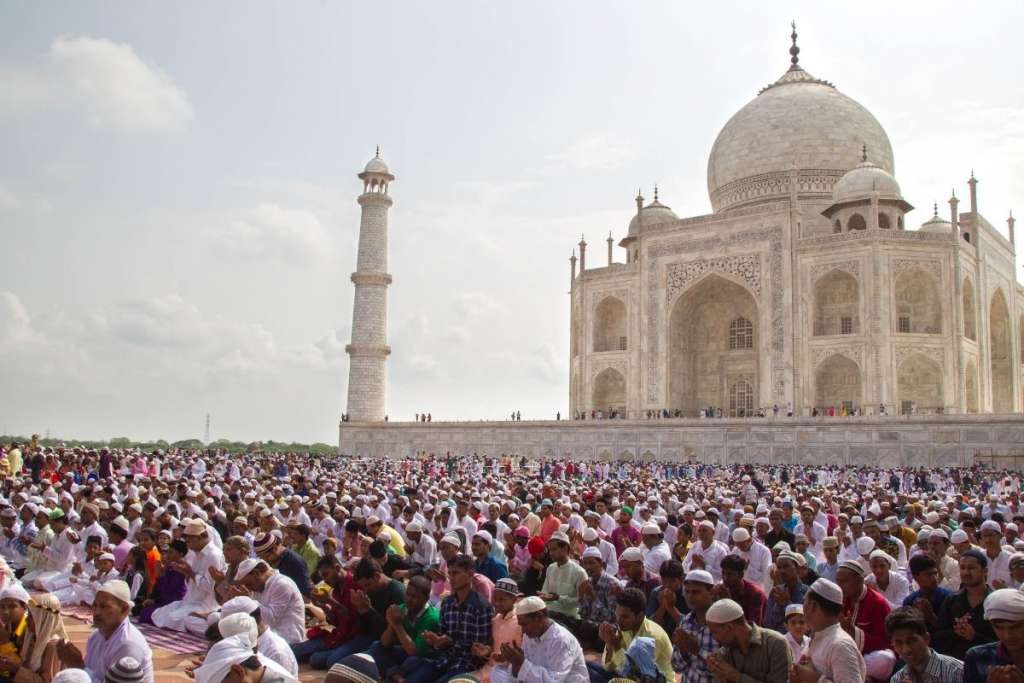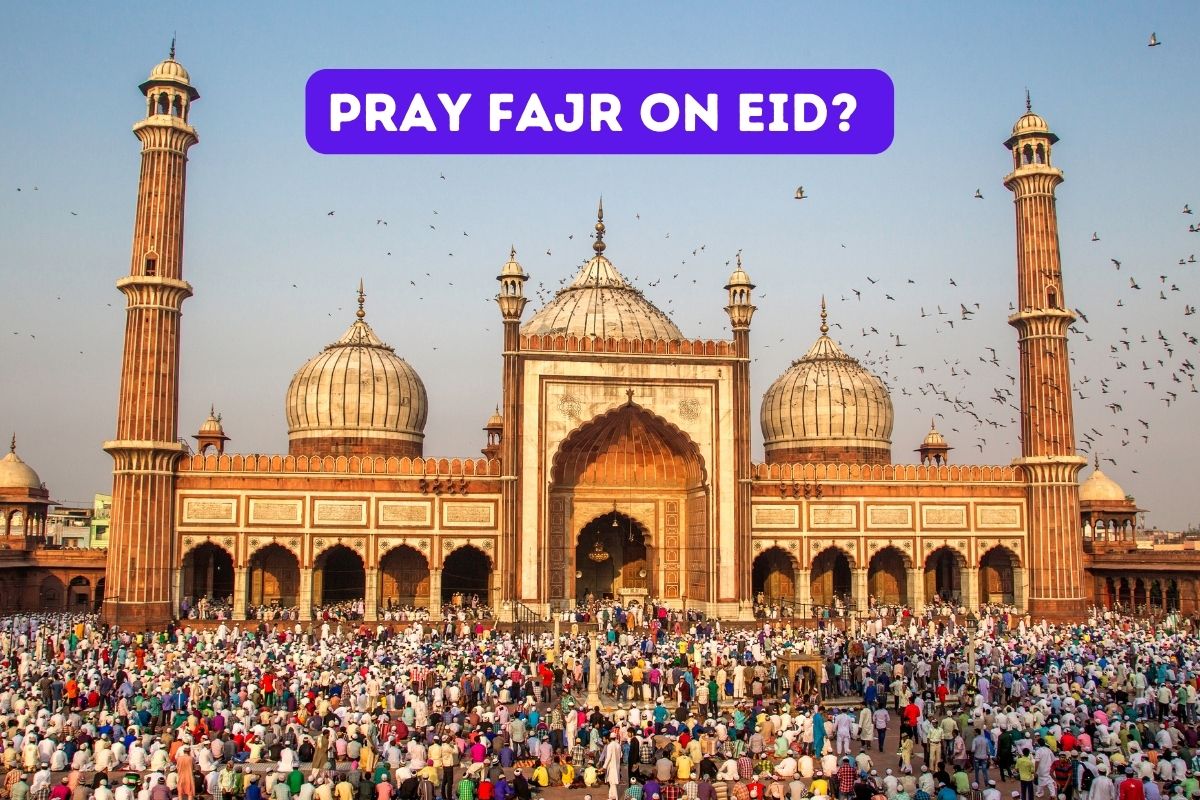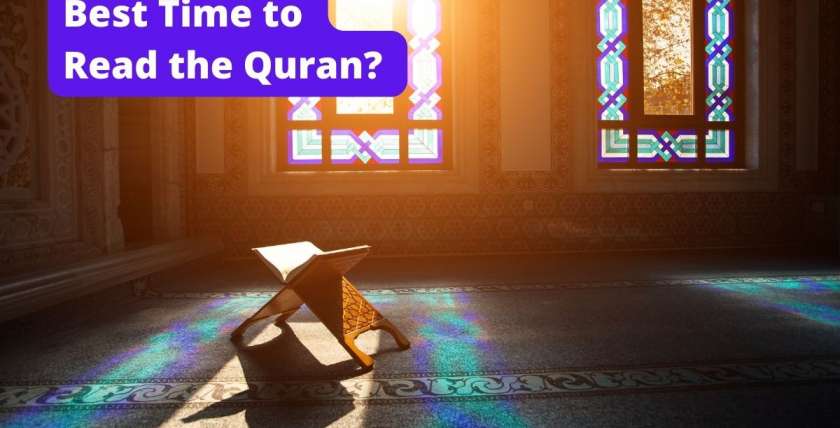In this article, we will learn everything about Eid, and one of the questions that we will answer is Do you pray Fajr on Eid or not?
Do you pray Fajr on Eid? Yes, Fajr prayer is prayed on Eid, but keep in mind that Eid prayer can’t be prayed right after Fajr. Wait until 15 minutes after the sunrise then pray it, and you can pray it any time until 10 before Duhr prayer.
Now if you want to learn more about Eid and Eid prayer then keep reading.
What is Eid?

Eid meaning in English is “festival” or “feast”. In Islam, there are two major Eids which are Eid al-Fitr (Festival of Breaking Fast) which comes after Ramadan the month of reading the Quran and doing good deeds. Eid al-Fitr marks the end of Ramadan (the month of fasting) and it is the first three days of Shawwal (the 10th month of the Islamic calendar)
Then comes Eid al-Adha (Festival of Sacrifice). During this festival the Muslims that are capable of buying sheep, goats, camels, or cows to sacrifice, they do so. They buy what they can afford and divide the flesh of the animal among themselves, the poor, and friends and neighbors. Also, during this Eid people tend to visit their friends and family.
Eid al-Fitr is a three-day festival and there are many Eid gift ideas to celebrate it with your friends and family. The second Eid is Eid al-Adha which is the larger Eid, it is a four days festival.
How do Muslims celebrate Eid al-Fitr?
During Eid al-Fitr, people celebrate with each other by saying “Eid Mubarak,” meaning “Blessed Eid”. They tend to prepare sweet dishes at home like Maamoul, and cookies. Give candy and gifts to kids and the ones in need. Also, Muslims tend to seek forgiveness and Allah’s mercy.
The celebration of the Eid differs from one country to another. In high Muslim population countries, Eid al-Fitr is a national holiday. No work, or schools. People celebrate Eid with their family or friends.
How do Muslims celebrate Eid al-Adha?

Eid al-Adha comes at the end of the Hajj (capable Muslims go to the holy city of Mecca in Saudi Arabia) to do the pilgrimage.
This Eid tells us the story of how Allah commanded the prophet, Ibrahim, to sacrifice his son Ismail to test his faith. And how Ibrahim informed his son Ismail. They both accepted Allah’s command and as Ibrahim was about to sacrifice his son, Allah intervenes and a ram is sacrificed in place of Ismail. So, during this Eid Muslims sacrifice animals in remembrance of this story.
Can I pray the Eid prayer at home?
Eid prayer should be prayed in congregation at the mosque or and open place prepared for the salah. However, when there is a pandemic like Covid-19 you can pray it at home.
How to pray Eid prayer at home?
1- Listen to the imam in the mosque outside or open the tv on salat al-Eid/ search for it on the internet and follow the imam’s lead.
2- Eid prayer is a two-rakah prayer. Start by making your Niyah.
3- When the imam raises his hands and says “Allahu Akbar”, you should do the same. Then you will recite the al-Istiftah Dua. Afterward, the imam will say “Allahu Akbar” 3 times and you will repeat after him and raise your hands after each utterance. After raising your hands put them back down by your sides. “Allahu Akbar” means “The Lord is the most magnificent” or “Allah is the greatest.”. while al-Istiftah Dua is the dua that refers to starting the salah. There are multiple dua but here are one of them: غَيْرُكَ (Subhanaka Allahumma wa bihamdika wa tabarakasmuka, wa ta’ala jadduka wa la ilaha ghairuk).
4- Now put both your hands on your chest, place the right hand on top the left hand. The imam will now recite surah Al Fatiha and then a second Surah. The sunnah is to recite surah Al A’la in the first rakah. Listen to the imam carefully and try to focus.
5- When the imam finishes the surah, you will perform what is called Ruku, meaning that you will bow and place your hands on your knees and say “Subhaana rabiyal ‘adheem” three times. Try to make your back parallel to the ground and look at the ground. Then when you hear the imam saying “Sami Allahu liman Hamidah”, stand up again and say “Rabbana lakal Hamd”, and they both mean “Allah hears those who praise him,” and “Our Lord, praise be to You.
6- Now when the imam says “Allahu Akbar.” You will go into sujud. You get onto your knees with your forehead touching the ground and say “Subhaana rabiyal a’la” three times. Then you will sit and do another sujud. And this is the end of the first rakah.
7- The imam will say “Allahu Akbar” and you will stand back up. Then the imam will recite surah Al Fatiha and another Surah. The sunnah is to recite Surah Al Ghashiyah in the second rakah. During this listen carefully and try to focus.
8- When the imam raises his hands and say “Allahu Akbar”, you should do the same. Then you will recite the al-Istiftah Dua. Afterwords the imam will say “Allahu Akbar” 3 times and you will repeat after him. Then go to ruku after the third “Allahu Akbar”. Now say “Subhaana rabiyal ‘adheem” three times. Try to make your back parallel to the ground and look at the ground. Then when you hear the imam saying “Sami Allahu liman Hamidah”, stand up again and say “Rabbana lakal Hamd”, and they both mean “Allah hears those who praise him,” and “Our Lord, praise be to You.
9- when the imam says “Allahu Akbar.” You will go into sujud. You get onto your knees with your forehead touching the ground and say “Subhaana rabiyal a’la” three times. Then you will sit and do another sujud.
10- When you finish the second sujud sit and say the Tashahhud as follows:
التَّحِيَّاتُ لِلَّهِ وَالصَّلَوَاتُ وَالطَّيِّبَاتُ السَّلَامُ عَلَى النَّبِيُّ وَرَحْمَةُ اللَّهِ وَبَرَكَاتُهُ السَّلَامُ عَلَيْنَا وَعَلَى عِبَادِ اللَّهِ الصَّالِحِين. أَشْهَدُ أَنْ لا إِلَهَ إِلَّا اللَّهُ وَأَشْهَدُ أَنَّ مُحَمَّدًا عَبْدُهُ وَرَسُولُهُ
اللَّهُمَّ صَلِّ عَلَى مُحَمَّدٍ وَعَلَى آلِ مُحَمَّدٍ كَمَا صَلَّيْتَ عَلَى إِبْرَاهِيمَ وَعَلَى آلِ إِبْرَاهِيمَ إِنَّكَ حَمِيدٌ مَجِيدٌ. اللَّهُمَّ بَارِكْ عَلَى مُحَمَّدٍ وَعَلَى آلِ مُحَمَّدٍ كَمَا بَارَكْتَ عَلَى إِبْرَاهِيمَ وَعَلَى آلِ إِبْرَاهِيمَ إِنَّكَ حَمِيدٌ مَجِيد
Attahiyyaatu lillaahi wassalawaatu wattayyibatu. Assalaamu ‘alayka ayyuhan-Nabiyyi warahmatullaahi wabarakaatuh. Assalaamu ‘alyna wa ‘ala ‘ibaadillaahis saaliheen. Ash-hadu an laa ilaaha illallaah wa ash-hadu anna Muhammadan ‘abduhu wa rasooluh.
Allaahumma salli ‘ala Muhammad wa ‘ala aali Muhammad kama sallaita ‘ala Ibraaheem wa ‘ala aali Ibraaheem innaka Hameedun Majeed, wabaarik ‘ala Muhammad wa ‘ala aali Muhamaad kama baarakta ‘ala Ibraaheem wa ‘ala aali Ibraaheem innaka Hameedun Majeed.
Meaning: “All the compliments are for Allah and all the prayers and all the good things (are for Allah). Peace be on you, O Prophet, and Allah’s mercy and blessings (are on you). And peace be on us and on the good (pious) worshipers of Allah. I testify that none has the right to be worshipped but Allah and that Muhammad is His slave and Apostle.
O Allah! Praise Muhammad, and on the family of Muhammad, as You Praised Ibraaheem and the family of Ibraaheem; you are indeed Worthy of Praise, Full of Glory. And send blessings on Muhammad, and on the family of Muhammad, as you sent blessings on Ibraaheem, and the family of Ibraaheem; you are indeed Worthy of Praise, Full of Glory.”
11- When you finish the Tashahhud turn your face to the right and say “Assalamu alaikum Wa Rahmatullah.” Then turn your face to the left and repeat the prayer again.
If you still have any questions visit our website QuranOnline.com






